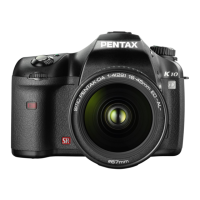Over 30 patents have been filed for this SR system, which uses a ball-bearing-mounted oscillator unit with
four electromagnets that hold the free-floating image sensor. Angular velocity sensors detect camera
movement and relay the amount of compensation necessary to the electromagnets that move the sensor to
compensate for any shake.
As a result, photographers can capture sharp images at a shutter speed that is 2 – 3.5 stops slower with
the K100D and 2.5 – 4 stops slower with the K10D (e.g. 1/15 sec instead of 1/60 sec with a standard lens)
than would otherwise be possible. The SR system provides a crucial advantage when shooting handheld
with telephoto or tele-zoom lenses, at macro distances, or any other situation that magnifies the effects of
camera shake. The SR system also helps considerably when taking non-flash pictures indoors or at dusk or
other low light situations without using a tripod.
Additional Advantages of the PENTAX SR System
● Since the SR system is activated only when you press the shutter release, any effect on battery
consumption is negligible.
● PENTAX SR is optional. You can leave SR on permanently, turning it off only when using a tripod or
panning (deliberately moving the camera in the direction of subject motion to blur the background).
● Performance capabilities such as auto-focus speed, shutter lag time and continuous shooting rate
are unaffected by the SR system because its operation is instantaneous, occurring within the normal
exposure interval.
● By building the shake-reduction system into the body, the Pentax SR system provides maximum
flexibility and requires no compromises in optical quality.
● To provide optimal shake reduction, the camera must “know” the focal length of the lens in use.
Pentax F, FA, D-FA, and DA series lenses automatically relay focal length information to the camera.
With older lenses, the Pentax K100D allows users to manually input focal length information via the
Shake Reduction menu which allows focal lengths all the way from 8mm to 800mm.
The SR system in the K10D and K100D is an engineering achievement and an example of PENTAX’s
commitment to our legacy of lenses.
K10D Specifications

